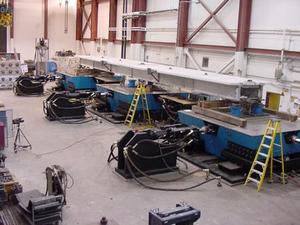EarthquakesLarge shake tables expands capabilities of U Nevada, Reno’s quake engineering lab
When it opens, the University of Nevada, Reno’s new Earthquake Engineering Laboratoryt will join with the internationally renowned Large-Scale Structures Laboratory to comprise the largest and most versatile structural engineering experimental facility in the United States. Researchers at the facility will conduct research aiming to test new designs and materials that will make buildings, bridges, and highways safer.

Three of the shake tables at UN Reno // Source: nsf.gov
Three 14- by 14-foot, 27-ton table platens were lifted and placed onto their base mats in the University of Nevada, Reno’s new Earthquake Engineering Laboratory as the installation of equipment in the expanded facility nears completion.
Lifting these tables into place with 30-ton cranes is the last major step in a 6-month-long equipment-installation project that has involved moving three of the University’s four shake tables from the existing Large-Scale Structures Lab to the new Earthquake Engineering Lab.
A University of Nevada, Reno release reports that when it opens, the new lab will join with the internationally renowned Large-Scale Structures Laboratory to comprise the largest and most versatile structural engineering experimental facility in the United States.
“It has been quite an undertaking to move into the new space,” Ian Buckle, civil engineering professor and lab director, said. “New hydraulic systems - hoses, pumps, hardlines — have been installed in the basement of the new building and, so far, three of our four shake tables and their controllers have been disassembled, moved, and are now being reassembled.”
Equipment moved to the new space makes way for additional and varied engineering experiments to take place in the existing Large-Scale Structures Lab, where one of the University’s four shake tables still remains to be moved.
“To me, this is the most complicated project we’ve ever done because the shake tables are themselves extremely complex; and the move is extremely technical and difficult,” Patrick LaPlace, lab manager, said.
“The way I like to think of it is if you’re going to move a refrigerator you would put it on a dolly and move it. It’s not that easy with a 50-ton shake table. Instead what we are doing is like taking the refrigerator apart, breaking it down all the way to the individual screws, drain the fluid out, disassemble the compressors, everything, move each part over and then rebuild it from the ground up. That’s what we’re doing with the shake tables and the system that runs them.”
The new Earthquake Engineering Lab on the University of Nevada, Reno campus is adjacent to the Rogers-Weiner Large-Scale Structures Laboratory and the Harry Reid Engineering Laboratory in the southeast area of the campus.
Researchers at the facility conduct world-improving research, testing new designs and materials that will make buildings, bridges and highways safer. The engineering program provides access to agencies and private industry to help them be successful in their product and infrastructure development while providing exceptional educational opportunities for students and workforce development for industry.
The release notes that the University was awarded $12.2 million from the U.S. Dept. of Commerce’s National Institute of Standards and Technology (NIST) to fund the major portion of the new Earthquake Engineering Lab.
The $20 million project also received funds from the Department of Energy and the University of Nevada.
Other features of the expansion include offices, state-of-the-art control room and an auditorium with telecommunication features to share knowledge with researchers in the NEES consortium around the country as well as researchers around the world.
The expansion project began in November 2010. Equipment installation is near completion and testing and commissioning of the equipment is expected to begin in March. An opening celebration of the expanded facility is planned to take place in early summer.
“This expansion is a major accomplishment that will make us more competitive and productive,” Manos Maragakis, dean of the College of Engineering, said. “Our facility will be unique worldwide and, combined with the excellence of our faculty and students, will allow us to make even greater contributions to the seismic safety of our state, the nation and the world.”
